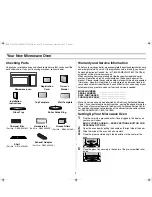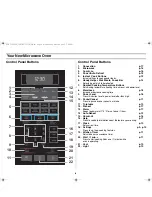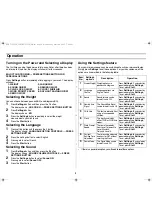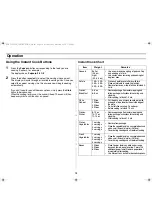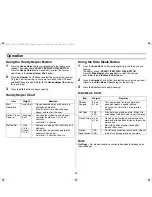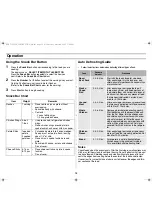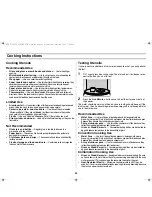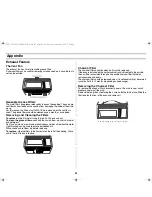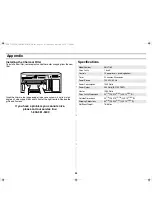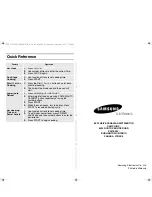
21
Cooking Instructions
Cooking Techniques
Stirring
Stir foods such as casseroles and vegetables while cooking to distribute heat
evenly. Food at the outside of the dish absorbs more energy and heats more
quickly, so stir from the outside to the center. The oven will turn off when you
open the door to stir your food.
Arrangement
Arrange unevenly shaped foods, such as chicken pieces or chops, with the
thicker, meatier parts toward the outside of the turntable where they receive
more microwave energy. To prevent overcooking, place thin or delicate parts
toward the center of the turntable.
Shielding
Shield food with narrow strips of aluminum foil to prevent overcooking. Areas
that need shielding include poultry wing-tips, the ends of poultry legs, and cor-
ners of square baking dishes. Use only small amounts of aluminum foil.
Larger amounts can damage your oven.
Turning
Turn foods over midway through cooking to expose all parts to microwave
energy. This is especially important with large items such as roasts.
Standing
Foods cooked in the microwave build up internal heat and continue to cook
for a few minutes after the oven stops. Let foods stand to complete cooking,
especially foods such as roasts and whole vegetables. Roasts need this time
to complete cooking in the center without overcooking the outer areas. All liq-
uids, such as soup or hot chocolate, should be shaken or stirred when cook-
ing is complete. Let liquids stand a moment before serving. When heating
baby food, stir well and test the temperature before serving.
Adding Moisture
Microwave energy is attracted to water molecules. Food that is uneven in
moisture content should be covered or allowed to stand so that the heat dis-
perses evenly. Add a small amount of water to dry food to help it cook.
Venting
After covering dish with plastic wrap, you vent plastic wrap by turning back
one corner so excess steam can escape.
General Microwave Tips
•
Dense foods, such as potatoes, take longer to heat than lighter foods. Foods with
a delicate texture should be heated at a low power level to avoid becoming tough.
•
Altitude and the type of cookware you are using can affect cooking time. When
using a new recipe, use the minimum cooking time and check the food
occasionally to prevent overcooking.
•
Foods with a non-porous skin such as potatoes or hot dogs, should be pierced to
prevent bursting.
•
Frying with heating oil or fat is not recommended. Fat and oil can suddenly boil
over and cause severe burns.
•
Some ingredients heat faster than others. For example a jelly doughnut will be
hotter than the dough. Keep this in mind to avoid burns.
•
Home canning in the microwave oven is not recommended because all harmful
bacteria may not be destroyed by the microwave heating process.
•
Although microwaves do not heat the cookware, the heat from the food is often
transferred to the cookware. Always use pot holders when removing food from the
microwave and instruct children to do the same.
•
Making candy in the microwave is not recommended as candy can be heated to
very high temperatures. Keep this in mind to avoid injury.
Guide for Cooking Eggs in Your Microwave
•
Never cook eggs in the shell, and never warm hard-cooked eggs in the shell; they
can explode.
•
Always pierce whole eggs to keep them from bursting.
•
Cook eggs just until set; they become tough if overcooked.
Guide for Cooking Vegetables in Your Microwave
•
Vegetables should be washed just before cooking. Often, no extra water is
needed. If dense vegetables such as potatoes, carrots and green beans are being
cooked, add about ¼ cup of water.
•
Small vegetables (sliced carrots, peas, lima beans, etc.) can be cooked faster than
larger ones.
•
Whole vegetables, such as potatoes, acorn squash or corn on the cob, should be
arranged in a circle on the turntable before cooking. They will be cooked more
evenly if turned over after half the cooking time.
•
Always place vegetables like asparagus and broccoli with the stem ends pointing
towards the edge of the dish and the tips toward the center.
•
When cooking cut vegetables, always cover the dish with a lid or vented
microwavable plastic wrap.
•
Whole, unpeeled vegetables such as potatoes, squash, eggplant, etc., should
have their skin pricked in several spots before cooking to prevent them from
bursting.
•
For more even cooking, stir or rearrange whole vegetables halfway through the
cooking time.
•
Generally, the denser the food, the longer the standing time. (Standing time refers
to the time necessary for dense, large foods and vegetables to finish cooking after
they come out of the oven.) A baked potato can stand on the counter for five
minutes before cooking is completed, while a dish of peas can be served
immediately.
SMV7165STD_INSTRUCTION_GB.fm Page 21 Wednesday, March 2, 2005 7:42 PM

